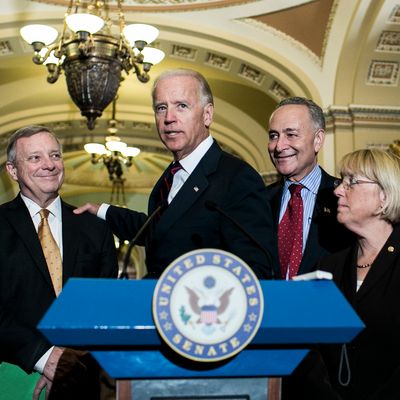
If you aren’t familiar with the arcana of congressional procedure, it may seem confusing when pundits talk about President Biden and Democrats having to choose between bipartisan negotiations or a partisan strategy using “reconciliation” to advance their legislative agenda. “Reconciliation” sure doesn’t sound partisan.
But in fact, budget reconciliation has become the principal method whereby a Senate majority can get big things done absent any (or at least much) support from across the aisle. The device allows legislation with a tangible fiscal impact to be enacted under special rules providing for limited debate and requiring only a majority vote. This is crucial in the Senate due to the filibuster, which maintains that 60 votes are required to enact pretty much anything.
Here’s how budget reconciliation came to be, and how it may be used to enact Biden’s agenda.
The origins of budget reconciliation
Reconciliation was created by the Congressional Budget Act of 1974, and was originally envisioned as a fallback disciplinary measure aimed at congressional committees that ignored the spending or revenue targets in the annual budget resolutions that are the centerpiece of the Budget Act. The idea was that, near the end of the year, Congress could, if necessary, enact a “reconciliation” bill to reconcile the actual legal authority for spending and revenues with the budget resolution adopted earlier. Mechanically, that meant passage of reconciliation instructions that would dictate the construction of a reconciliation bill by the House and Senate Budget Committees.
But in 1981, the Reagan administration, under its famously innovative budget director David Stockman, figured out a new way to use reconciliation early in the year: to package desired spending or revenue measures into a fast-moving bill that could reduce vast and controversial measures to a single up-or-down vote in both Houses. This “front-loaded reconciliation” revolutionized congressional budgeting, and for any administration with working control of both Houses, greatly enhanced a president’s power to get big batches of legislation enacted. (Reagan’s Republicans had a majority of the Senate in 1981, and worked out a deal to gain the support of moderate-to-conservative House Democrats, given them a practical majority there as well.)
How it’s been used over the years
Budget reconciliation proved so powerful that former House Speaker Paul Ryan called it “a bazooka in my pocket” once Republicans won the White House and both Houses of Congress in 2016. It was used not just by Reagan but by every subsequent president, with such notable products as the George W. Bush’s tax cuts and Obama’s Affordable Care Act (in its final form, after Democrats lost their supermajority in the Senate).
As Ryan predicted, Republicans used reconciliation to pursue the repeal of the Affordable Care Act in 2017 but narrowly failed because they couldn’t keep Republicans in line. They also used reconciliation successfully to enact Trump’s tax-cut package later that same year. Now, with Democrats holding their own governing trifecta, they plan to use reconciliation to enact key party priorities if, as is very likely, Republicans block them in the Senate.
The limitations of reconciliation
The Budget Act provides for only one reconciliation bill for each annual budget resolution. The Senate rules for reconciliation also stipulate that it can only be used for legislation deemed germane to the budget (provisions in Biden’s American Rescue Plan, such as a minimum wage increase or an eviction moratorium, could be subject to a point of order as non-germane); cannot be used to make changes to the Social Security program; and cannot increase the federal budget deficit beyond a ten-year “window” (which means some spending or tax cut provisions may have to be temporary rather than permanent).
These limitations and the points of order they create go under the general title the Byrd rule, named after former senator Robert Byrd, and the discussions with the Senate parliamentarian to determine compliance with the Byrd Rule are called a Byrd bath. Uncertainty on Byrd rule compliance can be a major problem in designing and packaging a reconciliation bill.
The budget resolutions that create reconciliation “instructions” (essentially authorizing a reconciliation bill) are purely creatures of Congress and don’t require a presidential signature. The actual reconciliation bill is regular legislation and must be signed or vetoed by the president, which is why the whole process is rarely used without governing trifectas or practical control of the White House and both Houses of Congress.
How Democrats plan to use reconciliation in 2021
Lucky for Democrats, Congress did not enact a budget resolution for the current 2021 fiscal year. That means two reconciliation bills can be enacted this calendar year (one for this fiscal year and one for the next). The Biden administration and congressional Democratic leaders plan to use the first to enact COVID-19 relief and stimulus legislation, in the likely event that a bipartisan deal cannot be worked out with Republicans, to avoid or overcome a Senate filibuster. A second bill will still be available for other legislation later.
Even more than Republicans in 2017, Democrats this year do not have a margin for error: In the Senate, a single Democratic defection (unless there is a countervailing Republican defection) would be fatal. That’s why Senate Democratic “centrists” like Joe Manchin and Kyrsten Sinema will likely have virtual veto power over the scope, composition, and timing of reconciliation bills.
Budget reconciliations could yet become a “bazooka” for Joe Biden. But without careful handling, it could backfire as well. Just ask the Republican sponsors of the effort to repeal Obamacare.






























